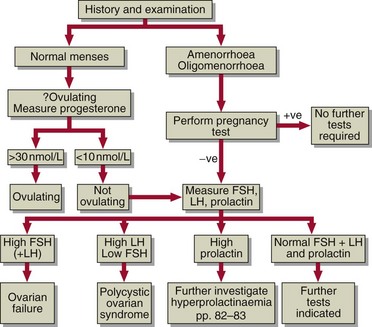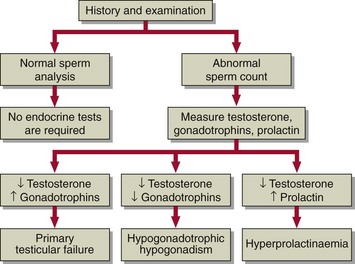Subfertility
Endocrine investigations in the subfertile woman
In women who present with irregular or absent menstruation (oligomenorrhoea or amenorrhoea) or who are not ovulating, hormone measurements may be diagnostic. A protocol for investigation is shown in Figure 51.1. Measurement of oestradiol and gonadotrophin concentrations may detect primary ovarian failure or polycystic ovarian disease. Measurement of prolactin, and androgens, may also assist.
Endocrine causes of subfertility in women include:
 Excessive androgen secretion by the ovaries in response to insulin resistance. This is commonly a feature of central obesity.
Excessive androgen secretion by the ovaries in response to insulin resistance. This is commonly a feature of central obesity.
 Primary ovarian failure. This is indicated by elevated gonadotrophins and low oestradiol concentration (a postmenopausal pattern). Hormone replacement therapy assists libido and prevents osteoporosis, but does not restore fertility.
Primary ovarian failure. This is indicated by elevated gonadotrophins and low oestradiol concentration (a postmenopausal pattern). Hormone replacement therapy assists libido and prevents osteoporosis, but does not restore fertility.
 Hyperprolactinaemia (pp. 84–85).
Hyperprolactinaemia (pp. 84–85).
 Polycystic ovarian disease. This is indicated by an elevated LH and normal FSH. Oestradiol measurements are often unhelpful. Hirsutism, a feature of this condition, is associated with raised testosterone and subnormal sex hormone binding protein concentrations.
Polycystic ovarian disease. This is indicated by an elevated LH and normal FSH. Oestradiol measurements are often unhelpful. Hirsutism, a feature of this condition, is associated with raised testosterone and subnormal sex hormone binding protein concentrations.
 Cushing’s syndrome (pp. 98–99).
Cushing’s syndrome (pp. 98–99).
 Hypogonadotrophic hypogonadism. Rarely, subnormal gonadotrophin and oestradiol concentrations suggest the presence of a hypothalamic–pituitary lesion such as interference from a pituitary tumour.
Hypogonadotrophic hypogonadism. Rarely, subnormal gonadotrophin and oestradiol concentrations suggest the presence of a hypothalamic–pituitary lesion such as interference from a pituitary tumour.
Endocrine investigations in the subfertile man
In the eugonadal male with normal sperm analysis, no endocrine investigations are required. In the hypogonadal male, testosterone and the gonadotrophins should be measured first (Fig 51.2). Causes of subfertility in the male include:
 Primary testicular failure. Where both the interstitial cells and tubules are damaged, FSH and LH will be elevated and testosterone reduced. Where tubular function only is impaired, FSH is selectively increased and androgen levels may be normal.
Primary testicular failure. Where both the interstitial cells and tubules are damaged, FSH and LH will be elevated and testosterone reduced. Where tubular function only is impaired, FSH is selectively increased and androgen levels may be normal.
 Hypothalamic–pituitary disease. Decreased testosterone with low or normal gonadotrophins suggests hypogonadotrophic hypogonadism.
Hypothalamic–pituitary disease. Decreased testosterone with low or normal gonadotrophins suggests hypogonadotrophic hypogonadism.
 Hyperprolactinaemia. This is a rare cause of subfertility in the male (pp. 84–85).
Hyperprolactinaemia. This is a rare cause of subfertility in the male (pp. 84–85).







